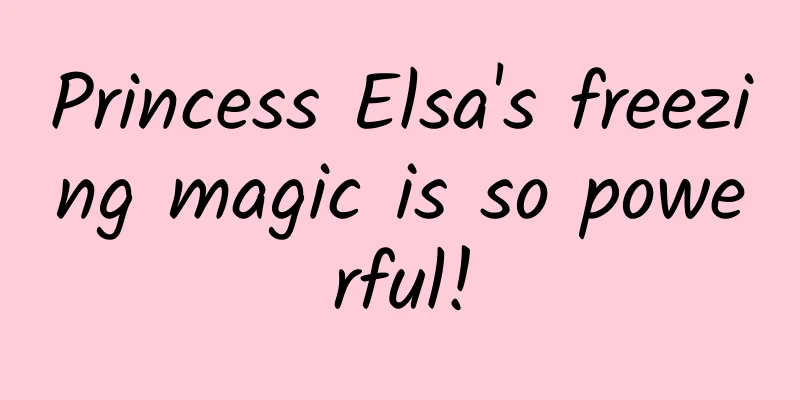Princess Elsa's freezing magic is so powerful!

|
How powerful is Princess Elsa's freezing magic? Author: Zhu Lei Children who like "Frozen" know that Princess Elsa has a magical power. As long as she takes off her gloves and points her fingers, she can instantly freeze a large area into ice. From a physics point of view, Princess Elsa is equivalent to a powerful refrigerator that can rapidly cool down the water vapor in the surrounding air and freeze it into ice. What is the physical principle of a refrigerator? Let's take a look at the refrigerator at home. It can freeze the water vapor in the air in the freezer into ice, because the temperature of the freezer can be as low as -18 degrees Celsius. The ambient temperature outside the refrigerator may be 40 degrees Celsius. If the refrigerator is powered off and not working, the temperature of the freezer will be the same as the ambient temperature outside the refrigerator, and the popsicles you worked so hard to freeze will only melt. Once the refrigerator is powered on, the electricity drives the compressor to work, compressing the gaseous refrigerant. The gaseous refrigerant gains energy, its pressure rises, and its temperature also rises. After entering the condenser, it releases heat and condenses into liquid. Then, the liquid enters the capillary tube, and due to the obstruction of the capillary tube, the pressure is reduced and it enters the evaporator. The compressor expands in turn, which further reduces the pressure in the evaporator and accelerates the evaporation of the liquid. Evaporation is an endothermic process, which takes away the heat in the freezer, causing the temperature of the freezer to drop. The compressor works in a continuous cycle, pushing the refrigerant to circulate in the condenser, capillary tube and evaporator, which can reduce the temperature of the freezer to minus 18 degrees Celsius. Fluorine-free refrigerators and protection of the ozone layer Freon was a common refrigerant used in refrigerators. It is an organic substance that is easily vaporized and liquefied. However, it can decompose chlorine, which reacts chemically with the ozone layer in the atmosphere, thus destroying the ozone layer. The ozone layer can absorb most of the ultraviolet rays in sunlight, thus protecting humans, animals and plants on the earth from the harm of ultraviolet rays. As we have mentioned before, prolonged exposure to ultraviolet rays from the sun can cause damage to the skin. Therefore, the ozone layer is essential to protecting our health, and Freon is a killer that destroys the ozone layer. Therefore, people have made a decision to limit the production and use of Freon. my country stopped producing Freon in 2002. Now, all refrigerators sold in the Chinese market are fluorine-free refrigerators, and the refrigerant is no longer Freon, but tetrafluoroethane. The refrigeration process of refrigerators from the perspective of energy If we analyze the refrigeration process of a refrigerator from the perspective of energy, we will find that electrical energy is input into the compressor, causing the compressor to do work W (usually W is used to represent power) on the refrigerant, which is the conversion of electrical energy into mechanical energy. The refrigerant then releases heat Q1 (usually Q is used to represent heat, marked as Q1 here) to the outside through the condenser, and absorbs heat Q2 through the evaporator. According to the law of conservation of energy or the first law of thermodynamics, Q1=Q2+W. The heat (Q1) released to the outside world will cause the side wall of the refrigerator to heat up. Children can know this by touching their own refrigerator. Therefore, using a refrigerator may cause the temperature in your home to rise. This heat (Q1) is not needed. Children can think about how to use this energy and not let it dissipate into the air in vain. The heat (Q2) absorbed by the refrigerant through the evaporator is what we need. It can lower the temperature of the freezer, freeze popsicles, and preserve food for a long time. We hope it is as big as possible. The work done by the compressor consumes electricity, and we need to pay for electricity. Of course, the smaller the work, the better. In fact, people define a refrigeration coefficient Q2/W to represent the refrigeration performance of refrigerators, which is close to what we often call cost performance. We found that Q1 and Q2, one releases energy and the other absorbs energy. If they are equal, then there is no need for W, right? The refrigerator does not need to consume electricity. This does not seem to violate the law of conservation of energy and the first law of thermodynamics. But in fact, there is no such refrigerator. Why is this? Because in addition to the first law of thermodynamics, there is also the second law of thermodynamics: heat can only be transferred spontaneously from a high-temperature object to a low-temperature object, but not from a low-temperature object to a high-temperature object. So, in real life, you will see hot water and cold water mixed together, the hot water temperature drops, the cold water temperature rises, and eventually the two temperatures are the same. You will not see the hot water temperature getting higher and the cold water temperature getting lower. To achieve the latter situation, work must be done on them. In other words, if the refrigerator does not do work by inputting electrical energy, it is impossible to lower the temperature of the freezer and increase the temperature outside. If Princess Elsa spills tetrafluoroethane or dry ice, which will freeze faster? Let's talk about Princess Elsa's magic. If she waved her hand and sprinkled tetrafluoroethane, and then used her inner strength to compress the tetrafluoroethane to do work, the pressure of the tetrafluoroethane would increase, the temperature would rise, and it would release heat outward. Then Princess Elsa retracted her hand and used her inner strength to suck the tetrafluoroethane, the pressure would decrease, and it would evaporate quickly, absorbing a lot of heat, and then ice would form around it. This seems to make sense. But this operation requires Princess Elsa to have a deep inner strength like a martial arts master. Another method that does not require internal force is to use dry ice (solid carbon dioxide). Since the freezing point of dry ice is very low (minus 78.5 degrees Celsius), it quickly sublimates into gas in the air at room temperature. This process absorbs a lot of heat, causing the ambient temperature to drop, possibly below freezing. Therefore, Princess Elsa can freeze the surrounding area with just a wave of her hand and sprinkle dry ice. This process is equivalent to the high-temperature object (air) releasing heat to the low-temperature object (dry ice). It can be done spontaneously and does not require Princess Elsa to use her internal force to do work. It can be said that this is a very low threshold freezing magic. The only thing to be careful about is to prevent frostbite when carrying dry ice. Another thing is that Princess Elsa's magic freezing speed is extremely fast, almost in the blink of an eye. The energy transfer in this process is certain. The shorter the time, the higher the energy transfer per unit time, that is, the higher the power, because power = work ÷ time. We know that "a three-foot-thick ice does not form overnight." It seems that if Princess Elsa wants to freeze the world in front of her in an instant, the power required will be too high and it may be unrealistic. Of course, Frozen is a surreal fairy tale in its own right. Key Points 1. The principle of refrigerators. A refrigerator works by doing work on the refrigerant, causing it to release heat to the outside world. Then the refrigerant evaporates under reduced pressure, absorbs heat, and lowers the temperature to achieve a cooling effect. 2. The law of conservation of energy, the first law of thermodynamics and the second law of thermodynamics. The law of conservation of energy and the first law of thermodynamics state that energy can neither be created nor destroyed, but can only be transferred. The second law of thermodynamics states that energy transfer is directional and can only be spontaneously transferred from a high-temperature object to a low-temperature object, but not vice versa. To do the reverse, work must be done on the low-temperature object. This is why work must be input first in a refrigerator. 3. Power. Power is the work done per unit time. It takes a certain amount of time for a refrigerator to cool down. The freezing magic like that of Princess Elsa probably only exists in fairy tales. This article is excerpted from "Physics Enlightenment Lesson for Children" (written by Zhu Lei, China Women's Publishing House, 2022) |
<<: Attention! Many people suffer from this habit that hurts their knees!
>>: What causes bad taste in mouth? How to solve it!
Recommend
Tips for placing ads in Weibo Fans Information Flow!
Today I bring you several excellent information f...
Here are all the ways to improve your APP’s monetization capabilities!
How can an app with hundreds of thousands, million...
official! Tik Tok advertising promotion quotation list~
Tik Tok has seized the domestic video market and ...
Women must do these 10 health checks, especially after the age of 30!
If you have special health conditions or needs, p...
Have you ever seen a guy with afro who can walk 20 kilometers a day?
The national emblem of the Republic of Sudan look...
3 Spring Festival marketing strategies of Moutai, Nongfu Spring and Jiang Xiaobai
Many marketers are aware of the concepts of "...
Is Xiaohongshu’s “grass planting marketing” changing?
The trend of grass-roots marketing on Xiaohongshu...
Lanzhou self-service car wash mini program development function, how much does it cost to develop a self-service car wash mini program?
Nowadays, "cars" as a means of transpor...
Remdesivir clinical trial! What is remdesivir? What is the price?
As of February 7, a total of 31,214 cases of nove...
If you want to use iPhone 7 in winter, you have to be careful with the Home button
The new generation of iPhone 7 has caused a lot of...
I’d like to share with you a way to make money that doesn’t require any traffic and can be done mindlessly. You can earn over 10,000 yuan a month. I suggest you make money quietly!
Today I want to share with you a way to make money...
Will wearing a mask for a long time cause lung nodules? Rumors on the September Science Rumors List
1. “The harm of betel nut is not as serious as ad...
The melee of China's low-code development platforms - Let's clarify low-code once and for all
Today we will talk about low code in a language t...
Why can't LG "copy" Samsung's success?
For Chinese consumers, LG is another Korean techn...
Analysis of the entire process of community operation (8 steps of comprehensive and detailed analysis)
Let’s stop talking nonsense and get straight to t...





![[Highly recommended] Four online tracking services to help you identify application anomalies](/upload/images/67ebd6414ed16.webp)



